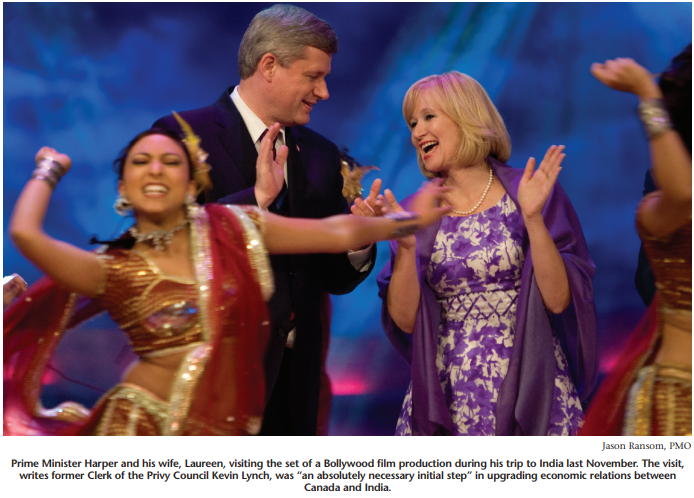
The development of a country’s foreign policy begins with a clear definition of one’s national interests; this is then overlaid with a deep understanding of the global environment and domestic context the country faces; then through these filters the coherent priorities, initiatives and actions that give effect to this unique reflection of a country’s purpose and ambition are crafted. All these considerations would make India a foreign policy priority for Canada.
The shared experiences of Canada and India are rooted in our parliamentary democracies, our federal systems of government, our legal codes, our Commonwealth heritage and English as one national language. Even more fundamentally, our links are grounded in a shared commitment to developing pluralistic societies. While India’s pluralism is the product of 5,000 years of history, Canada’s clearly is not as old, but our commitment is strong. There are few peoples on earth that can look to Canada and not see their own reflection, and that is certainly true of Indians; there are more than 1 million Canadians of Indian origin.
Yet, notwithstanding this and India’s astounding growth over the last decade, the trade and investment links between Canada and India are surprisingly small for two $1.5-trillion economies. Annual trade in each direction is just over $2 billion per year, investment flows have been modest until recently, and science and technology links are only beginning to grow, with the signing of an S&T agreement in 2005. What is equally striking is the lack of knowledge about Canada and the absence of a “Canada brand” in India.
The obvious but difficult question is why this is so. A number of explanations are routinely advanced: the Air India bombing; the nuclear safeguards issue; vocal support for Kashmir independence groups by some locals in Canada; periodic tilting in India toward noncapitalist alignments of nations; an Indian focus on but wariness about the US; and India’s unique historical relationship with the United Kingdom. But whatever the reasons, surely the extent of our commonality demands a stronger relationship, in the national interests of both countries.
India is not a simple country. It is a country of amazing physical, social and economic diversity. It is exhausting in the sheer pace of its living and working, surviving and striving. Since the economic reforms of the early 1990s, as India began to cast off elements of its closed economy and state-driven policies of the past, the Indian economy has been rapidly changing and growing. Indeed, as the global economy emerges from the financial crisis and recession, Asia, including India, is going to be relatively stronger and more influential. There is a palpable sense of confidence, pride and even destiny among Indian business leaders. Despite its many challenges, India has enormous potential to unleash.
Indian politics are fractious and fractured. The press is feisty, and the English language newspapers are interesting. It is an incredibly poor country with some incredibly rich people. It is a developing country with home-grown, world-class high-technology industries. Globally successful entrepreneurs coexist with advocates of statist policies and protectionism. Indians of all social and income strata are unbelievably consumed with personalities, stars, Bollywood, glamour — it is a topic that unifies billionaires and peasants, elites and masses. The infrastructure is terrible, and the ability of Indians to work around it and jerry-rig solutions is astounding. The mirror image of the seeming chaos of overcrowded Indian cities is an extraordinary energy and dynamism.
India is the world’s most populous democracy. In the 2009 election, over 700 million Indians were eligible to vote, with polling stretching over a month and overseen by one of India’s most impressive institutions, the National Election Commission. The voting was judged to be free and fair. Most remarkable is the attachment of India’s rural poor to the right to vote. They view this as a source of power, in a life where they are usually powerless; exercising this right to vote appears to serve as a national shock absorber for the tensions of inequality and poverty.
So far so good, but the bane of the Indian electoral system has been the large number of regional parties, extremist parties, nationalist parties and personality cult parties. The result is large, bulky and frequently unstable coalitions, where often the only common denominator is power. And a troubling consequence is a lack of accountability and problems with corruption. Encouragingly, despite fears to the contrary, the recent 2009 election saw a diminution in the power of regional parties.
India’s foreign policy has long been characterized by balances, straddling east and west, north and south, large and small, market and socialist countries. The relationship with Pakistan is primordial. The US and India have had a somewhat frosty courtship, with India worried about the closeness of the US to Pakistan and yet wanting a counterweight to growing Chinese power in the region. Links with Russia have ebbed and flowed depending on the state of relationships with China and the US, and how socialist any particular Indian government coalition was. Afghanistan has historic ties with India; it has been both a corridor for and a buffer against invasion since time immemorial.
It is a country of amazing physical, social and economic diversity. It is exhausting in the sheer pace of its living and working, surviving and striving. Since the economic reforms of the early 1990s, as India began to cast off elements of its closed economy and state-driven policies of the past, the Indian economy has been rapidly changing and growing.
India’s institutions reflect the diversity that is so much a part of the country. Some of the elite universities, particularly the Indian Institutes of Technology and the Indian Institutes of Management, are small and excellent, with strong professors and extraordinary students. Many universities are not. The Indian Administrative Service is an elite and merit-based public service. Many of the provincial and local public services are not. Corruption and bureaucratic red tape can be stifling, and yet entrepreneurship and innovation flourish despite this. India is modernizing its military capacity but the Mumbai attacks showed the security, intelligence and emergency response elements of the military and national police still have a ways to go.
India is now working its way through the first global economic crisis since it emerged as an economic powerhouse. Reaping the benefits of its early 1990s reforms, India achieved average growth of 8.75 percent during the period 2003 to 2007. It combined this strong growth with a significant reduction in poverty. The main driver of growth in India was domestic demand, not exports, as in China. The surge in investment, the key element of this domestic demand growth, was financed by rising Indian private and public savings, and by increasing foreign capital inflows, as India’s economy began to integrate with the rest of the world. But India has done little to implement further reforms and build on the progress of the 1990s.
During the global financial crisis, India’s financial system avoided the worst of the banking woes experienced by financial institutions in the United States and Europe — a remarkable achievement. The global recession, more than the financial crisis, is causing rising credit risk pressures. Indian banks appear reasonably well capitalized and liquid, with acceptable nonperforming asset ratios. However, the rapid domestic credit expansion of recent years, combined with a sharp increase in foreign liabilities, has increased the vulnerability of Indian banks to a prolonged period of slow global growth and deleveraging.
Impressively, India, like China, avoided recession in the global downturn. Growth is expected to be 6.5 percent in 2010, and stronger thereafter. Government policy measures to stimulate the economy in the global recession were aimed at supporting consumption through subsidies and infrastructure through stimulus spending. Since India has not been as reliant on export-led growth as China or Japan, it should be better positioned than its Asian neighbours if the US and European recoveries are weak.
After five years of fiscal consolidation, India’s public finances deteriorated markedly amidst the global economic crisis. A soaring subsidy bill, the stimulus measures and slowing growth have led to a substantial widening of the deficit, now over 7 percent of GDP. Public debt, which is over 80 percent of GDP, is too high and rising. India, like many other countries, now needs to design and implement a macroeconomic “exit” strategy, which should include the entrenched domestic subsidies.
Two of the most transformative changes in the Indian economy since reforms of the early 1990s have been the rise of the entrepreneur and the growth of a private-sector middle class. While estimates of its size vary widely, all suggest the Indian middle class is many times larger than the entire Canadian population. And the dynamics are staggering: with real economic growth between 8 and 9 percent and population growth of 1.5 percent, per capita incomes will double every nine years. This growing middle class, concentrated in burgeoning urban centres, is demanding better infrastructure, more effective and transparent local administration and an efficient and effective rule of law.
At the sectoral level, India offers potential for Canadian firms in infrastructure, property development, natural resources and services. The Indian infrastructure deficit increasingly has a chokehold on growth, and India must mirror what China has already begun and invest massively in its public and private infrastructure to support sustained high growth. The growing middle class wants modern shopping facilities and better housing, while service sector businesses want more modern commercial buildings. All are areas in which Canada has business expertise and experience. India’s energy production and transmission are very inefficient and costly, again an area of Canadian business strength. Its services, particularly financial, engineering and communications, will expand enormously, and Canada has a sophisticated financial sector and a positive reputation coming out of the financial crisis.
The financial crisis and the worldwide recession will have lasting implications for the global economy, interacting with structural shifts already under way. As the world’s economic centre of gravity shifts, it is estimated that by the end of this decade half of all global goods and services could be produced in the IndiaJapan-China economic triangle. For Canada, the “advantage of proximity” to the US marketplace will increasingly be counterbalanced by the “tyranny of distance,” as we decide how best to connect to these emerging powerhouses.
During the global financial crisis, India’s financial system avoided the worst of the banking woes experienced by financial institutions in the United States and Europe — a remarkable achievement.
In this rapidly changing global dynamic, Canada’s national interests quite simply call for a stronger relationship with India. What might the architecture of such a new partnership look like? It would start, as the Canadian and Indian governments have already begun, by removing historical impediments, such as tensions over nuclear safeguards. But to build the stronger, deeper relationship that is called for will require new approaches in our foreign policy and innovations in how we build the partnership.
First, we need to build strong networks between India and Canada, operating on four levels concurrently: between political leaders, between business leaders, between senior public servants and between university leaders. Over the last year, there has been an appreciable increase in the political attention shown to our Indian relationship, with visits by the Prime Minister, ministers and senior officials. This was an absolutely necessary initial step. Sustaining such political and public service engagement through ongoing visits will maximize the impact. An eminent persons advisory group, consisting of leaders from both countries in these domains, could assist in building a stronger relationship.
Second, given the pivotal role Indian entrepreneurs are playing in transforming their economy, links between Canadian and Indian business leaders are crucial. There must be strong private sector engagement to develop the relationship. To help nurture this, government and business need to identify sectors and areas where win-win business partnerships are possible. Such areas could include the service sector (banking, insurance, engineering services, etc.), the natural resource sector (including our technological capacity to enhance oil and gas recovery, processing and transmission), property development to satisfy the needs of the middle class (malls, multiuse complexes, housing) and infrastructure, given the huge Indian infrastructure deficit.
Third, we need to build a “Canada brand” in India. The reality is that brand recognition in India emanates from products (e.g., iPods), culture (e.g., Hollywood), history (the UK) or education (e.g., Harvard University, the University of Oxford). The good news is that we don’t have a negative brand; the less good news is we have essentially no brand at all. Establishing a Canadian brand will require investments in brand development. The potential to create a unique Canada brand image is clearly there, and the potential payoffs are evident from the Australian efforts at branding the Land of Oz.
There is an excellent base from which to construct a brand. There are surprisingly strong cultural links between Bollywood and Canada to draw on. We have high technology companies like RIM and the iconic Canadarm to appeal to a nation that admires technology.
Fourth, we have a strong university research system whose strengths are not known in India, but a collective approach by our universities to building research partnerships could reverse this. We have fascinating people-to-people links and the stories these could tell in our respective media. And we have much in common in terms of our global economic interests, and business pioneers to validate this potential.
Fifth, we need to support a stronger relationship through a new Canada-India economic partnership agreement, partly to brand the relationship, partly to deal with perceived impediments to doing business and partly to lay the framework for future growth. The design of an agreement should include services, investment protection, intellectual property rights and protections, deepening the existing S&T agreement and dispute resolution mechanisms. It is doubtful such an agreement could successfully include trade in goods, particularly agriculture, which is constrained in both countries, and these areas might best be left to multilateral efforts.
A deeper relationship with India is in Canada’s national interests and is equally valuable to India as it reshapes its relationships with the rest of the world. To continue to grow at the transformative pace of the last decade, India must continue to change, to encourage market-driven activity and entrepreneurship at home and to build new bridges and relationships abroad. To prosper in the shifting global economy, Canada must enlarge the markets for Canadian firms and build new partnerships outside the countries where we have historically concentrated our trade and investment and technology linkages. The payoff is long term, and so too must be the commitment by the two countries’ governments, businesses and universities. The relationship needs formal structures and informal networks; it needs a new generation of economic agreements and extensive people-to-people links.
For India, there are many possible pitfalls ahead, but they are more than matched by amazing potential. As Nandan Nilekani, one of the founders of Infosys and a leading Indian entrepreneur, observed in his fascinating book on this transforming India, Imagining India: The Idea of a Renewed Nation: “This is what is unique about the Indian growth story. A people-driven transformation of a country holds a particular power; it is irreversible.” We should share his optimism.
Photo: Shutterstock










